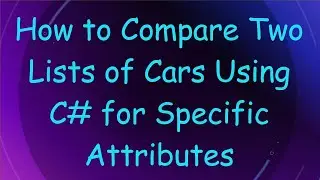Key Differences Between XML and HTML
Understand the fundamental differences between XML and HTML, including their purposes, syntax rules, and how they are used in web development.
---
Disclaimer/Disclosure - Portions of this content were created using Generative AI tools, which may result in inaccuracies or misleading information in the video. Please keep this in mind before making any decisions or taking any actions based on the content. If you have any concerns, don't hesitate to leave a comment. Thanks.
---
Key Differences Between XML and HTML
In the realm of web development, XML (eXtensible Markup Language) and HTML (HyperText Markup Language) are pivotal technologies used to structure data and format web pages. Although they share similarities, they serve different purposes and follow distinct rules and principles. Below, we will explore the key differences between these two markup languages.
Purpose
XML
XML is primarily designed to carry data and store it in a self-descriptive format. Its main goal is to facilitate the sharing of structured information across different systems, especially over the internet. It offers a way to create custom tags, enabling users to define their own data structures and schemas.
HTML
HTML, on the other hand, is specifically crafted to display data and to focus on the presentation of the information. It provides the framework for designing and structuring web pages, enabling text, multimedia, and interactive forms to be presented seamlessly on the web.
Syntax Rules
XML
XML follows strict syntax rules:
It is case-sensitive.
Tags must be properly closed.
XML documents must have a single root element that encompasses all other elements.
Attributes must be quoted.
HTML
HTML is more forgiving:
It is not case-sensitive.
Some tags can be left unclosed (e.g., <br>, <img>).
HTML uses predefined tags and attributes and does not allow any deviations from its syntax.
Structure Flexibility
XML
XML provides flexibility in defining custom tags and attributes. This allows developers to create structures that are tailored to specific applications and needs.
HTML
HTML has a predefined tag set, which means developers are restricted to using only those tags and attributes defined by the HTML specification. This ensures uniformity across different web platforms and browsers.
Usage Context
XML
XML is widely used in various applications beyond web development, such as in configuration files, data exchange formats (e.g., RSS, SOAP), and representing complex data structures.
HTML
HTML’s primary usage is in web development to lay out and format web pages. It's the foundation of how web pages are presented to users in their browsers.
Self-Descriptive Capability
XML
XML is inherently self-descriptive. Each element carries its own metadata within its tags, making the data easily understandable without additional documentation.
HTML
HTML does not aim for self-description. Instead, it relies on the browser to interpret and render the predefined tags according to web standards.
In conclusion, while both XML and HTML are fundamental to web technology, their roles differ significantly. XML is designed to structure and transport data, while HTML is focused on showcasing that data on the web. Understanding these distinctions is crucial for any web developer or individual working in fields related to data and web technologies.































